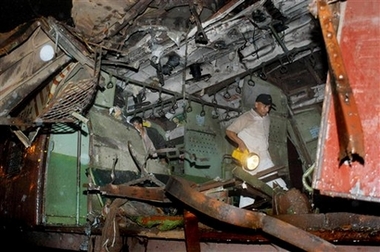Redundancy and Capacity on the Washington, DC subway system
(Dupont Circle photo by DottieboBottie.)
From a friend:
It took me over an hour to get from Brookland to Downtown - some problem at Dupont. THE train was overpacked. disgusting. I really understand why people do not believe in transit
My response:
The real problem is that the system:
1. Was under-designed. When you only have two tracks, you lack redundancy, and on any line, a problem with one train multiplies immediately. Putting a track out of service even for a few minutes screws things up up and down the system.
2. Needs more cars. During peak periods the trains need more cars. Especially when you can count on some trains going out of service. This reduces packing by increasing capacity. It also provides a kind of redundancy and flex in the system's ability to move people around.
From "Transit without borders or five omissions "in" the Transportation Element of the DC "Comprehensive" Plan," from July 2006:
There are at least five major omissions in the Transportation Element, three have to do with regional issues, and two are city-specific.
1. Regardless of the cost, the idea of adding capacity to the subway system, along the lines of the long since dropped separate blue line proposal from 2001-2002 (and earlier), needs to be put back on the table.
The subway system is getting great usage. It needs more cars and a better intra-car seating configuration to get more throughput. But at some point, only so many trains can get through the system, based on the current configuration. One issue is the subway tunnel at Rosslyn. But another is that there are only two tracks. For redundancy and throughput purposes, this must be addressed.
Dan Tangherlini brought up streetcars as a way to improve intra-city transit, in response to the WMATA plan, because he said that it won't be possible to raise the money to create this separate line (which had two proposed H Street NE stations by the way). But it needs to be reconsidered.
See:
-- "Coming to a Curve: Region's Subway System Begins to Show Its Age, Limits" By Lyndsey Layton, Washington Post, March 25, 2001; Page A01
--"Crowds Could Derail Decades of Progress," By Lyndsey Layton, Washington Post, March 26, 2001; Page A01. From this article:
Many of Metro's capacity problems can be traced to its design. It was built as a two-track railroad, with five lines stretching from the city core to the suburbs in a hub-and-spoke arrangement.The two-track design means big trouble when a train breaks down. The train has to be hauled down the track until it reaches one of just a few sidings where it can be pulled off the main track. That slows movement on the entire line and explains why a breakdown at Farragut North can affect passengers waiting for trains at Union Station."
We're like a two-lane country road with no breakdown lane," White said. The two-track railroad also prevents Metro from running express trains. And 24-hour service is out of the question, because Metro needs to shut down its system several hours a day to perform track maintenance. Larger systems such as New York's, which has up to six tracks at some stations, can perform maintenance on two tracks while running service on others, and can operate round-the-clock.
The other crucial flaw is the fact that four of Metro's lines share track for significant stretches. The Orange and Blue lines, for instance, merge at Rosslyn, then share track through a tunnel under the Potomac River and across downtown Washington until they separate at the Stadium-Armory Station.
Forcing the lines to share track cuts the capacity of each by half and is the main reason inbound Orange Line trains at, say, West Falls Church are standing room only during rush hour. Because a certain distance must be maintained between trains, there's a limit to the number of trains that can be sent down the Orange and Blue track each hour. Plans to extend rail service to Dulles and Tysons Corner may help ease crowding on the roads in an area that lacks rail service. But lengthening the Orange Line to Dulles will exacerbate crowding, by reducing the capacity of the Orange and Blue lines even further.
-- "Metro Construction Projects Creak to Halt; Economic, Political Changes Cancel Expansion Plans, Spur Job Cuts, Early Retirements," Lyndsey Layton. Washington Post, July 13, 2003. pg. C.01. From the article:
Metro headquarters pulsed with big plans. P. Takis Salpeas, the head of construction, was swimming in fresh designs: rail to Tysons and Dulles, a Purple Line that would circle the city, a rail line over the new Woodrow Wilson Bridge, a new subway line through downtown that would finally bring Metro to Georgetown and release the railroad's choke points.
That was two years ago. Today, those plans have largely evaporated, victims of a soured economy and fractured local politics. Metro is not building the next generation of transit -- it is barely able to run its existing system. As construction money dwindles from the current fiscal year through fiscal 2009, Metro's stable of well-regarded architects, engineers and construction managers will be cut from 237 to 23.
Speaking of terrorism, if only for redundancy purposes, adding capacity and separate tracks should be addressed. After all, it's supposed to be a "Comprehensive" Plan.
A rescue worker surveys the interior of a destroyed train coach after a bomb blast at the Matunga railway station in Bombay, India, Tuesday, July 11, 2006. Eight explosions ripped through packed commuter trains during rush hour Tuesday in India's commercial capital, killing nearly 150 people and injuring another 439 in what officials said was a well-coordinated bomb attack by terrorists. (AP Photo). From "Bomb attack on Bombay trains kills 190."




0 Comments:
Post a Comment
<< Home